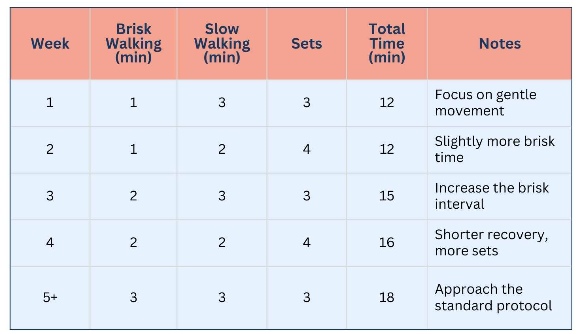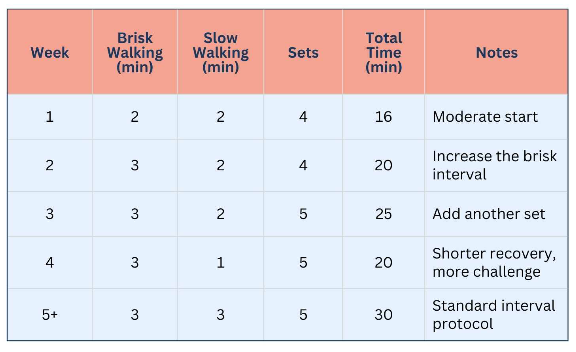In this article
Ever heard of “Japanese walking?” Often called “Japanese interval walking” or Interval Walking Training (IWT), it’s blowing up on social media—and for good reason. This simple, science-backed method mixes short bursts of fast walking with slower strolls, making it an easy (and surprisingly effective) way to boost your health and fitness. Bonus: it’s gentle enough for people dealing with hormonal imbalances, too!
Unlike high-intensity interval training (HIIT), IWT is a low-impact, accessible, and sustainable walking routine for people of all ages and fitness levels. Its unique protocol—three minutes of fast walking at about 70% maximum effort, followed by three minutes of slower walking at 40% effort, repeated for 30 minutes—has been shown to deliver significant improvements in cardiovascular, metabolic, and psychological health.
This article explores Japanese walking, how it works, and the benefits and considerations for those navigating hypothyroidism, perimenopause, menopause, andropause, and weight gain.
Japanese interval walking was developed by researchers in Japan as a low-impact, accessible exercise protocol. The core idea is simple: alternate between periods of fast and slow walking to maximize health benefits in a short period of time.
The standard protocol involves:
- 3 minutes of brisk walking: Aim for about 70% of your maximum heart rate. You should be able to speak, but not hold a full conversation.
- 3 minutes of slow walking: Drop to about 40% of your maximum heart rate. This is a comfortable recovery pace.
- Repeat this 5 times, totaling 30 minutes per session.
- Frequency: At least 4 to 5 times per week is recommended for optimal benefits.
The alternating pace challenges your heart, lungs, and muscles more than steady walking, but without the risks associated with high-impact or high-intensity workouts. This approach is less intense than high-intensity interval training (HIIT) but more effective than continuous moderate walking. This makes it ideal for older adults, people experiencing hormonal imbalances, and people trying to lose weight or living with chronic health conditions.
Japanese walking has gone viral because it combines simplicity, science, and impressive results in a way that fits with today’s approach to wellness. This method transforms a basic walk into a powerful, fat-burning, heart-strengthening routine—without needing a gym or equipment. It’s gaining traction because it aligns with the growing demand for gentle, sustainable wellness practices. All in all, Japanese walking feels more like a smart life upgrade than a fitness fad.
Here’s a viral post from popular TikTok fitness coach Eugene Teo on TikTok:
As Teo says in the video: “All movement is medicine, but if you’re short on time or want to get the most bang for your buck, this is for you!” Let’s find out why!
The name “Japanese walking” comes from a study out of Japan nearly 20 years ago that showed some pretty impressive results. Researchers found that middle-aged and older adults who did interval walking—alternating 3 minutes of brisk walking with 3 minutes of slower strolling for 30 minutes a day, at least four days a week—ended up with lower blood pressure, stronger legs, and better endurance than those who walked at a steady, moderate pace.
Other studies have compared interval walking with traditional continuous walking, and found that IWT resulted in:
- Improved cardiovascular fitness: Participants in interval walking studies experienced greater improvements in aerobic capacity and leg strength compared to those who walked at a steady pace.
- Lower blood pressure: Interval walkers experienced more significant reductions in blood pressure compared to those doing continuous moderate walking.
- Better blood sugar control: Interval walking improved blood glucose regulation, which is especially important for people with metabolic concerns.
- Weight management: Interval walkers lost more weight and body fat than those who simply increased their daily step count.
Hormones are chemical messengers that regulate your metabolism, mood, energy, fat distribution, and many other physiological processes. Research has shown that disruptions or declines in hormone levels—common during midlife transitions and in certain health conditions—can lead to weight gain, fatigue, mood changes, muscle loss, and increased risk of chronic disease. Exercise, particularly interval-based walking, can help rebalance these systems.
Hypothyroidism
Hypothyroidism results in low thyroid hormone levels, causing symptoms such as fatigue, weight gain, depression, and slowed metabolism. These symptoms can make exercise challenging, but physical activity remains vital for managing an underactive thyroid.
Japanese walking has benefits for people with hypothyroidism:
- Metabolic boost: Even moderate exercise like IWT can help counteract the sluggish metabolism of hypothyroidism, promoting weight loss and energy.
- Improved cardiovascular health: Interval walking has been shown to lower blood pressure, improve cholesterol levels, and enhance aerobic capacity more than steady-paced walking. This is especially beneficial for people with hypothyroidism, who are at increased risk for cardiovascular issues due to slower metabolism and potential changes in heart function.
- Enhanced muscle strength and physical function: Studies indicate that interval walking can significantly strengthen thigh muscles, improve flexibility, and boost overall physical endurance. This is particularly valuable for those with hypothyroidism, who may experience muscle weakness and joint discomfort.
- Better blood sugar and weight management: The alternating pace of interval walking helps regulate blood sugar and promotes greater calorie burn compared to regular walking, supporting weight loss and metabolic health. Weight management is often a challenge for people with hypothyroidism, making this a notable advantage.
- Mental health and mood benefits: Regular interval walking can help improve the release of endorphins, enhance mood, improve sleep quality, reduce symptoms of depression and anxiety, and improve cognitive function. These mental health benefits are well-documented and particularly relevant for those with hypothyroidism, who frequently struggle with mood changes and fatigue.
- Low-impact and joint-friendly: Unlike running or high-intensity activities, interval walking is gentle on the joints, making it suitable for individuals who experience joint pain or stiffness, which are common symptoms in hypothyroidism.
- Accessible and time-efficient: Requires no special equipment or gym membership and can be performed almost anywhere. The time-efficient nature of interval walking (about 30 minutes per session) makes it easier to fit into busy schedules.
- Adaptable to fitness levels: The interval structure can be modified—shorter or less intense intervals for beginners or those with more severe hypothyroid symptoms, gradually increasing as fitness improves.
Perimenopause and menopause
During perimenopause and menopause, estrogen and progesterone levels fluctuate and decline, leading to symptoms such as hot flashes, mood swings, sleep disturbances, and increased central fat accumulation. These hormonal shifts also raise the risk of cardiovascular disease, osteoporosis, and insulin resistance.
Japanese walking has many benefits for women in perimenopause and menopause.
- Improved metabolic health: IWT has been shown to regulate blood sugar, improve insulin sensitivity, and enhance metabolism—key benefits for women experiencing menopausal metabolic slowdowns. Brisk walking after meals, in particular, helps stabilize blood glucose and reduce cravings, supporting weight management.
- Cardiovascular protection: Interval walking reduces systolic blood pressure significantly more than continuous walking. A drop of 10–15 mmHg in blood pressure can cut stroke risk by up to 40%, a critical benefit as cardiovascular risk rises post-menopause.
- Bone health: Weight-bearing activities like IWT help maintain bone density, crucial for postmenopausal women at risk of osteoporosis. Recent research suggests that IWT may be especially beneficial for women with lower baseline bone mineral density, with minimal adverse effects.
- Mood and mental health: IWT can reduce symptoms of depression by about 50%, likely due to endorphin release and improved neurotransmitter balance. This is particularly valuable as mood disturbances are common during perimenopause and menopause.
- Muscle and fat distribution: Physical activity helps counteract menopause-related muscle loss (sarcopenia) and central fat gain. Active women have greater lean mass and muscle strength, independent of hormone therapy.
Andropause (male midlife hormonal changes)

Andropause is a term that describes the decline in testosterone that occurs in men starting in midlife. This gradual decline in testosterone leads to reduced muscle mass, increased fat, lower energy, mood changes, and a higher risk for metabolic syndrome and cardiovascular disease.
Japanese walking can be helpful for men in midlife.
- Testosterone and growth hormone: Regular interval walking stimulates the release of growth hormone (GH) and may help maintain testosterone levels, supporting muscle mass and metabolic health. Obesity, especially visceral fat, suppresses GH; exercise can help reverse this trend.
- Fat loss and muscle preservation: IWT’s bursts of intensity rev up metabolism, burn visceral fat, and help preserve lean muscle, counteracting the body composition changes of andropause.
- Mood and cognitive benefits: Exercise reduces stress hormones, such as cortisol, and supports neurotransmitter balance, helping to alleviate mood disturbances and cognitive decline associated with low testosterone levels.
Overweight and obesity
Excess weight, particularly around the abdomen, disrupts the balance of insulin, leptin, and sex hormones. Obesity is linked to lower growth hormone, increased estrogen (from fat tissue aromatization), and higher cortisol, all of which perpetuate weight gain and metabolic dysfunction.
Japanese walking can support weight loss efforts in several ways.
- Insulin sensitivity: IWT improves blood sugar regulation and insulin sensitivity, reducing the risk of type 2 diabetes and metabolic syndrome.
- Fat loss: The interval format burns more calories and targets visceral fat more effectively than steady-state walking, helping reduce the hormonal disturbances associated with obesity.
- Stress reduction: Regular moderate exercise helps lower cortisol levels, which are often elevated in overweight individuals and contribute to further weight gain and insulin resistance.
The basic Japanese walking protocol consists of 3 minutes of brisk walking at 70% exertion/effort, followed by 3 minutes of slow walking at 40%, repeated for 30 minutes, 4 to 5 days per week.
Below are two tailored interval walking plans: one for sedentary beginners and another for those who already engage in regular physical activity. Both plans are designed to be safe, progressive, and easy to follow.
Gentle interval walking plan for sedentary beginners
This plan is for you if:
- You have been mostly inactive or are just starting to exercise.
- You have chronic fatigue, joint pain, or other health concerns requiring a cautious approach.

Here are some tips:
- Walk at a pace where you can still talk comfortably during brisk intervals.
- Take extra rest days as needed.
- If you experience joint pain, excessive fatigue, or dizziness, reduce the number of sets or the duration.
Interval walking plan for beginners who are already physically active
This plan is for you if:
- You walk regularly or engage in other moderate physical activities.
- You’re ready for a slightly more challenging but still beginner-friendly interval program.

Here are some key tips:
- Aim for a brisk pace that elevates your heart rate but is still manageable.
- Focus on good posture and stride.
- Adjust the number of sets or interval durations according to your comfort level.
Here are some additional tips to make Japanese walking safe.
- Consult your doctor first, especially if your thyroid levels are unstable or you have other health concerns.
- Start slowly: Begin with shorter sessions or fewer intervals, and gradually increase as your stamina improves.
- Always warm up and cool down: Warm up for 3 to 5 minutes with gentle walking before starting intervals, and cool down for 3 to 5 minutes after your session.
- Monitor your symptoms: Pay attention to how your body feels during and after exercise. Watch for signs of overexertion: excessive fatigue, muscle aches, joint pain, or heart palpitations.
- Prioritize recovery: Ensure you get enough rest between sessions. If you feel exhausted, take an extra day off.
- Stay hydrated and nourished: Proper nutrition and hydration are crucial for maintaining energy and promoting recovery, especially when your metabolism is slowed.
- Make it enjoyable: Listen to music, a podcast, or an audiobook, walk with a friend or your dog, or choose scenic routes to stay motivated.
- Use a fitness tracker: Tracking your heart rate with a fitness tracker can help you stay within safe intensity zones and monitor progress.
- Try a smartphone app: There are smartphone apps specifically designed for Japanese interval walking:
- The Japanese Walking Method app (iOS) guides you through the classic Japanese interval walking protocol, alternating 3 minutes of fast walking with 3 minutes of easy walking, repeated five times for a 30-minute session. It offers real-time cues, motivation, and features like calorie calculation and streak tracking (some features require a subscription or one-time purchase).
- The IWT - Interval Walking Training app (Android) supports interval walking training by guiding users through alternating fast and slow walking cycles, making it suitable for those following the Japanese method. - Stick with it! Consistency and gradual progression are key to long-term success and safety.

While IWT offers significant health benefits, including improved cardiovascular fitness, muscle strength, and glycemic control, specific populations—such as people with hypothyroidism, women in perimenopause or menopause, men in andropause, and those who are overweight or obese—should consider the risks and challenges before starting this exercise approach.
People with hypothyroidism
- Fatigue and muscle weakness: Hypothyroidism often causes fatigue, muscle weakness, and joint pain, which may be exacerbated by high-intensity intervals. This can increase the risk of overexertion or injury, especially if exercise intensity is not carefully managed.
- Slower recovery: Reduced metabolic rate and impaired muscle repair in hypothyroidism can lead to slower recovery after exercise, increasing the risk of muscle soreness or injury.
- Cardiovascular concerns: Hypothyroidism can contribute to a slow heart rate (bradycardia) and other heart issues, so sudden increases in exercise intensity may pose cardiovascular risks. Medical clearance is recommended before starting interval training.
Women in perimenopause or menopause
- Decreased bone density: Lower estrogen levels can lead to reduced bone density, increasing the risk of stress fractures or joint injuries during high-impact or vigorous exercise.
- Hot flashes and thermoregulation: Interval training may trigger or worsen hot flashes and make temperature regulation more difficult.
- Mood and sleep disturbances: Perimenopausal and menopausal women often experience mood swings, insomnia, and fatigue, which can impact motivation, adherence, and tolerance to exercise.
Men in andropause
- Muscle weakness and fatigue: Andropause is associated with decreased testosterone, leading to muscle weakness, fatigue, and reduced exercise capacity. These symptoms can impair performance and increase the risk of injury during interval walking.
- Psychological Symptoms: Depression, anxiety, and poor concentration are common during andropause and may affect adherence and safety.
- Sleep disturbances: Insomnia is prevalent and can further reduce energy and recovery capacity, increasing the risk of overtraining or accidents.
People who are overweight or obese and trying to lose weight
- Joint and musculoskeletal stress: Excess body weight increases the load on joints, particularly the knees and hips, which raises the risk of pain or injury during higher-intensity walking intervals.
- Lower adherence: Studies show that adherence to interval walking programs declines more rapidly in individuals with higher BMI, suggesting that additional support and gradual progression are needed for long-term success.
- Cardiometabolic risks: While interval walking can improve glycemic control and cardiovascular health, individuals with obesity and related comorbidities (e.g., hypertension, diabetes) should consult healthcare providers before starting to ensure safety.
General issues
- Intensity management: While interval walking is generally safe for older adults and those with chronic diseases, the intensity should be tailored to individual fitness and health status. Starting with a lower intensity and gradually increasing it is advised.
- Monitoring and support: Regular monitoring, especially during the initial phases, can help detect adverse symptoms early. If you have a chronic health condition, you may benefit from supervised programs or digital tools to promote adherence and safety.
- Long-term commitment: Maintaining interval walking over time can be challenging, especially for people with chronic health issues or higher body weight. Social support, group activities, and motivational strategies can help improve adherence.

As you consider integrating Japanese Interval Walking Training (IWT) into your wellness routine, it’s essential to recognize that exercise is just one pillar of hormonal health, and comprehensive support can make all the difference, especially when navigating complex conditions like hypothyroidism, perimenopause, menopause, andropause, and hormonal weight gain.
Paloma Health specializes in providing personalized, evidence-based care for individuals with thyroid disorders and hormonal imbalances. For those with hypothyroidism, Paloma Health offers at-home thyroid testing, virtual consultations with thyroid-savvy clinicians, and ongoing support to optimize medication and lifestyle strategies. This ensures that your exercise efforts, such as IWT, are complemented by precise medical management, helping to address fatigue, weight fluctuations, and mood changes that can otherwise undermine progress.
For women in perimenopause and menopause, Paloma Health’s holistic approach addresses the interplay between thyroid function and shifting sex hormones. The Paloma team can help tailor treatment plans that consider your thyroid and reproductive hormone changes, supporting symptom relief, metabolic health, and long-term disease prevention. Similarly, men experiencing andropause—the gradual decline in testosterone—can benefit from Paloma Health’s expertise in identifying and managing overlapping symptoms of thyroid and testosterone deficiency, which often contribute to weight gain, reduced energy, and mood disturbances.
Hormonal weight gain is a multifaceted challenge, often resistant to diet and exercise alone. Paloma Health’s integrative care model combines medical treatment, including GLP-1 medications, nutritional guidance, and behavioral coaching to address the root causes of weight changes, empowering you to break through plateaus and achieve sustainable results.
By partnering with Paloma Health, you gain access to a dedicated team that understands the nuances of hormonal health at every stage of life. Paloma’s support can help you maximize the benefits of Japanese Interval Walking Training and other lifestyle interventions while ensuring your medical needs are expertly managed.
Ultimately, the path to hormonal balance and vitality is most effective when exercise, clinical care, and ongoing education work together. With Paloma Health as your ally, you can confidently pursue a wellness strategy that’s tailored, comprehensive, and sustainable, helping you feel your best now and for years to come.
- Japanese interval walking alternates 3 minutes of brisk walking with 3 minutes of slow strolling, repeated five times for a 30-minute session, 4–5 days a week.
- Research shows that the Japanese interval walking training (IWT) protocol improves cardiovascular fitness, lowers blood pressure, enhances leg strength, and supports better blood sugar control compared to steady walking.
- People with hypothyroidism benefit from IWT’s ability to boost metabolism, improve mood, and support joint-friendly movement without overexertion.
- Women in perimenopause or menopause can use IWT to reduce hot flashes, stabilize blood sugar, protect bone density, and ease mood swings.
- Men experiencing andropause may see improvements in testosterone regulation, fat loss, energy, and cognitive function through regular interval walking.
- IWT is especially effective for weight loss, as it helps burn visceral fat, lowers cortisol levels, and improves insulin sensitivity, making it ideal for individuals with obesity or hormonal weight gain.

.webp)

%20(1).webp)


.webp)







